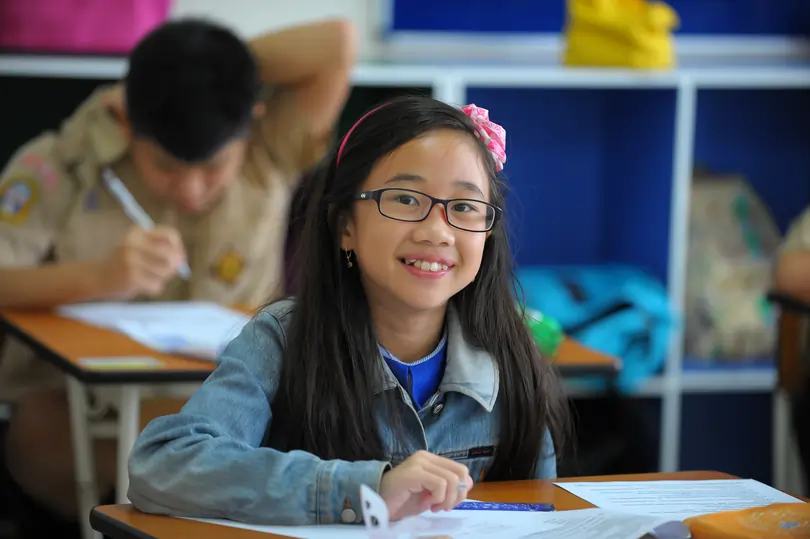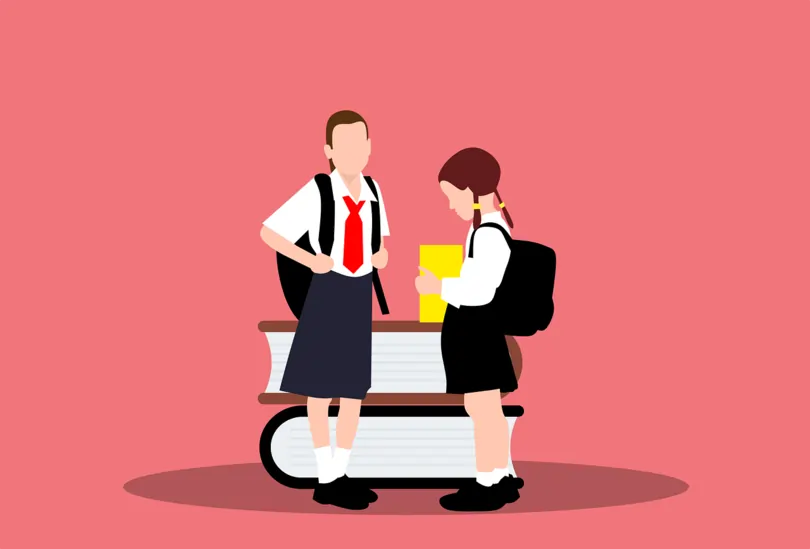Volume
Volume is the amount of space taken up by an object or the amount of liquid in a container. The unit of volume used in Primary 3 are millilitres (\(\text{mℓ}\)) and litres (\(\text{ℓ}\)).
In this article, the learning objectives are as follows:
- Comparison of volume based on figures
- Conversion of volume
- Comparison of volume
1. Comparison of volume based on figures
Question 1:
Which beaker has the least amount of water?
Solution:
Volume of water represents by each marking \(=50 \text{ mℓ }\)
Volume of water in Beaker A \(= 300 \text{ mℓ }\)
Volume of water in Beaker B \(= 350 \text{ mℓ }\)
Volume of water in Beaker C \(= 200 \text{ mℓ }\)
Volume of water in Beaker D \(= 250 \text{ mℓ }\)
Answer :
Beaker C is the one that contains the least amount of water.
Question 2:
Which beaker has the most amount of water?
Solution:
Volume of water represents by each marking on Beaker A & B \(= 10 \text{ mℓ }\)
Volume of water in Beaker A \(= 60 \text{ mℓ }\)
Volume of water in Beaker B \(= 80 \text{ mℓ }\)
Volume of water represents by each marking on Beaker C & D \(= 50 \text{ mℓ }\)
Volume of water in Beaker C \(= 200 \text{ mℓ }\)
Volume of water in Beaker D \(= 250 \text{ mℓ }\)
Answer:
Beaker D has the most amount of water
Note: Always take note of the total volume of the container as they can be different for different containers.
2. Conversion of volume
To convert volume in litres to millilitres and vice versa, we need to remember that:
\(1 \text{ ℓ } = 1000 \text{ mℓ }\)
Question 1:
\(2 \text{ ℓ } =\) __________ \(\text{ mℓ }\)
Solution:
\(2 \text{ ℓ } = 2000 \text{ mℓ }\)
Answer :
\(2000 \text{ mℓ }\)
Question 2:
\(3 \text{ ℓ } \; 500 \text{ mℓ } =\) __________ \(\text{ mℓ }\)
Solution:
\(\begin{align} 3 \text{ ℓ } &= 3000 \text{ mℓ } \\[2ex] 3000 \text{ mℓ } + 500 \text{ mℓ } &= 3500 \text{ mℓ } \end{align}\)
Hence,
\(\begin{align} 3 \text{ ℓ } \; 500 \text{ mℓ } = 3500 \text{ mℓ } \end{align}\)
Answer :
\(3500 \text{ mℓ }\)
Question 3
\(5800 \text{ mℓ } =\) __________ \(\text{ ℓ }\) __________ \(\text{ mℓ }\)
Solution:
\(5000 \text{ mℓ} =5 \text{ ℓ }\)
Hence,
\(5800 \text{ mℓ} = 5 \text{ ℓ } \;800 \text{ mℓ }\)
Answer :
\(5 \text{ ℓ } \; 800 \text{ mℓ }\)
3. Comparison of volume
Question 1:
Arrange the following in ascending order:
\(3 \text{ ℓ }\), \(30 \text{ mℓ }\), \(3 \text{ ℓ }\; 3 \text{ mℓ }\), \( 300 \text{ mℓ }\)
Solution:
\(\begin{align} 3 \text{ ℓ } &= 3000 \text{ mℓ }\\[2ex] 30 \text{ mℓ } &= 30 \text{ mℓ }\\[2ex] 3 \text{ ℓ } \; 3 \text{ mℓ } &= 3003 \text{ mℓ }\\[2ex] 300 \text{ mℓ } &= 300 \text{ mℓ } \end{align} \)
Answer:
\(30 \text{ mℓ}, \;300 \text{ mℓ}, \;3 \text{ ℓ}, \;3 \text{ ℓ } \;3 \text{ mℓ}\)
Note: The final answer must be in the original given quantities.
Question 2:
Which of the following has the greatest volume?
-
\(6 \text{ ℓ } \; 660 \text{ mℓ }\)
-
\(6 \text{ ℓ } \;606 \text{ mℓ }\)
-
\(6 \text{ ℓ } \; 600 \text{ mℓ }\)
-
\(6 \text{ ℓ } \; 66 \text{ mℓ }\)
Solution:
No conversion is required as \(6 \text{ ℓ }\) are common in all.
By comparing the \(\text{ mℓ }\) in all the options, the greatest volume is \(6 \text{ ℓ } \; 660 \text{ mℓ }\).
Answer:
(1) \(6 \text{ ℓ } \; 660 \text{ mℓ }\)
Question 3:
A packet of milk contains \(1 \text{ ℓ } \; 125 \text{ mℓ }\) of milk. A jar of apple juice contains \(680 \text{ mℓ }\) of apple juice. A bottle contains \(1 \text{ ℓ } \; 250 \text{ mℓ }\) of lemonade juice. Another bottle contains \(780 \text{ mℓ }\) of chilli sauce. Which of the following is of the least volume?
- milk
- apple juice
- lemonade
- chilli sauce
Solution:
We convert all into millilitres first.
Volume of the packet of milk\(\begin{align}\\[2ex] &= 1 \text{ ℓ } \; 125 \text{ mℓ }\\[2ex] &= 1125 \text{ mℓ } \end{align}\)
Volume of the jar of apple juice \(= 680 \text{ mℓ }\)
Volume of the bottle of lemonade \(= 1250 \text{ mℓ }\)
Volume of the bottle of chilli sauce \(= 780 \text{ mℓ }\)
Answer:
(2) The apple juice is of the least volume.
Question 4:
The diagram below shows the amount of water in 3 beakers at first. Sean poured \(200 \text{ mℓ}\) of water from Beaker A to Beaker C. He then poured \(100 \text{ mℓ }\) of water from Beaker C to Beaker B. Finally, he poured \(150 \text{ mℓ }\) of water from Beaker B to Beaker A. Which beaker had the least amount of water in the end?
Solution:
Volume of water represents by each marking on the beakers \(= 50 \text{ mℓ }\)
Volume of water in Beaker A \(= 300 \text{ mℓ }\)
Volume of water in Beaker B \(= 350 \text{ mℓ }\)
Volume of water in Beaker C \(= 200 \text{ mℓ }\)
Step 1:
Volume of water in Beaker A\(\begin{align}\\ &= 300 \text{ mℓ } – 200 \text{ mℓ } \\ &= 100 \text{ mℓ } \end{align}\)
Volume of water in Beaker C\(\begin{align}\\ &= 200 \text{ mℓ } + 200 \text{ mℓ } \\ &= 400 \text{ mℓ } \end{align}\)
Step 2:
Volume of water in Beaker C\(\begin{align}\\ &= 400 \text{ mℓ } – 100 \text{ mℓ } \\ &= 300 \text{ mℓ } & \text{(Final)} \end{align}\)
Volume of water in Beaker B\(\begin{align}\\ &= 350 \text{ mℓ } + 100 \text{ mℓ } \\ &= 450 \text{ mℓ } \end{align}\)
Step 3:
Volume of water in Beaker B\(\begin{align}\\ &= 450 \text{ mℓ } – 150 \text{ mℓ } \\ &= 300 \text{ mℓ } & \text{(Final)} \end{align}\)
Volume of water in Beaker A\(\begin{align}\\ &= 100 \text{ mℓ } + 150 \text{ mℓ } \\ &= 250 \text{ mℓ } & \text{(Final)} \end{align}\)
Answer:
Beaker A has the least amount of water in the end.
 SG
SG  VN
VN 












